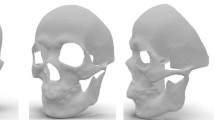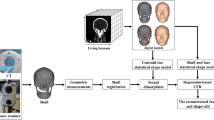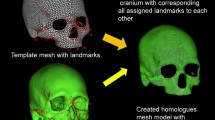Abstract
The field of 3D craniofacial similarity calculation and craniofacial relationships(the relationships between the human skull and face) analysis is a challenging and meaningful task in archaeology, forensic science, and anthropology. Although anthropologists have been involved in the application and illustration of craniofacial relationships in their research, due to the complexity of the 3D skull (with multiple holes), and the facial expression changes of 3D human faces, it is difficult to accurately perform 3D craniofacial similarity calculations and theoretical validation of craniofacial relationships are difficult. To address this challenge, we propose a data-driven framework that constructs a shape feature space based on spectral analysis to describe the intrinsic structure of 3D skulls and faces. Our framework includes a shape analysis method to measure 3D craniofacial similarity and a statistical method using canonical correlation analysis to comprehensively describe the craniofacial relationships from global statistical features and individual geometric features. Based on an Asian craniofacial database, we demonstrate the effectiveness of our framework through validation results and skull identification. Most importantly, we provide two craniofacial relationships rules through theoretical validation and numerical results: R1-the human skull has a strong correlation with the face; R2-the similarity change trend of the skull is generally consistent with the corresponding face similarity. These craniofacial relationships rules can be applied to general craniofacial analysis tasks and scenarios, providing a solid theoretical basis for relevant researchers. Our research represents a significant contribution to the field of 3D craniofacial similarity calculation and craniofacial relationships analysis.










Similar content being viewed by others
Data Availibility Statement
The datasets generated and/or analysed during the current study are not publicly available due the craniofacial database used in this paper consumes huge economic, human and material resources during the establishment, our research team only has the right to use this data set for research, and has no public right but are available from the corresponding author on reasonable request.
References
Todd W Fenton, Amber N Heard, and Norman J Sauer. Skull-photo superimposition and border deaths: identification through exclusion and the failure to exclude. Journal of Forensic Sciences, 53(1):34–40, 2008
Carl N Stephan. Craniofacial identification: techniques of facial approximation and craniofacial superimposition. Handbook of forensic anthropology and archaeology, 25:304–321, 2009
Maria Isabel Huete, Oscar Ibáñez, Caroline Wilkinson, and Tzipi Kahana. Past, present, and future of craniofacial superimposition: Literature and international surveys. Legal Medicine, 17(4):267–278, 2015
CN Stephan, Brandon Meikle, Nicolle Freudenstein, Ronn Taylor, and Peter Claes. Facial soft tissue thicknesses in craniofacial identification: Data collection protocols and associated measurement errors. Forensic Science International, 304:109965, 2019
Joi San Tan, Iman Yi Liao, Ibrahim Venkat, Bahari Belaton, and PT Jayaprakash. Computer-aided superimposition via reconstructing and matching 3d faces to 3d skulls for forensic craniofacial identifications. The Visual Computer, 36:1739–1753, 2020
Terrie Simmons-Ehrhardt, Catyana RS Falsetti, and Anthony B Falsetti. Using computed tomography (ct) data to build 3d resources for forensic craniofacial identification. In Biomedical Visualisation: Volume 9, pages 53–74. Springer, 2021
Carl N. Stephan and Maciej Henneberg. Building faces from dry skulls: Are they recognized above chance rates? Journal of Forensic Sciences, 46(3), 432–440, 2001
Mimi R Borrelli, Michael S Hu, Michael T Longaker, and Hermann Peter Lorenz. Tissue engineering and regenerative medicine in craniofacial reconstruction and facial aesthetics. The Journal of craniofacial surgery, 31(1):15, 2020
Christine Steiert, Simon Phillipp Behringer, Luisa Mona Kraus, Marco Bissolo, Theo Demerath, Juergen Beck, Juergen Grauvogel, and Peter Christoph Reinacher. Augmented reality–assisted craniofacial reconstruction in skull base lesionsan innovative technique for single-step resection and cranioplasty in neurosurgery. Neurosurgical Review, 45(4):2745–2755, 2022
Niankai Zhang, Junli Zhao, Fuqing Duan, Zhenkuan Pan, Zhongke Wu, Mingquan Zhou, and Xianfeng Gu. An end-to-end conditional generative adversarial network based on depth map for 3d craniofacial reconstruction. In Proceedings of the 30th ACM International Conference on Multimedia, pages 759–768, 2022
Sergio Damas, Oscar Cordón, Oscar Ibáñez, Sergio Damas, Oscar Cordón, and Oscar Ibáñez. Relationships between the skull and the face for forensic craniofacial superimposition. Handbook on Craniofacial Superimposition: The MEPROCS Project, pages 11–50, 2020
Ville Vuollo, Lasse Holmström, Henri Aarnivala, Virpi Harila, Tuomo Heikkinen, Pertti Pirttiniemi, and Arja Marita Valkama. Analyzing infant head flatness and asymmetry using kernel density estimation of directional surface data from a craniofacial 3d model. Statistics in medicine, 35(26):4891–4904, 2016
Carmen Campomanes-Álvarez, Rubén Martos-Fernández, Caroline Wilkinson, Oscar Ibáñez, and Oscar Cordón. Modeling skull-face anatomical/morphological correspondence for craniofacial superimposition-based identification. IEEE Transactions on Information Forensics and Security, 13(6), 1481–1494, 2018
Wuyang Shui, Mingquan Zhou, Steve Maddock, Yuan Ji, Qingqiong Deng, Kang Li, Yachun Fan, Yang Li, and Xiujie Wu. A computerized craniofacial reconstruction method for an unidentified skull based on statistical shape models. Multimedia Tools and Applications, 79:25589–25611, 2020
Tan-Nhu Nguyen, Vi-Do Tran, Ho-Quang Nguyen, and Tien-Tuan Dao. A statistical shape modeling approach for predicting subject-specific human skull from head surface. Medical & Biological Engineering & Computing, 58:2355–2373, 2020
Brandon Meikle and Carl N Stephan. B-mode ultrasound measurement of facial soft tissue thickness for craniofacial identification: A standardized approach. Journal of Forensic Sciences, 65(3):939–947, 2020
C. M. Wilkinson, M. Motwani, and E. Chiang. The relationship between the soft tissue and the skeletal detail of the mouth. Journal of Forensic Sciences, 48(4), 728–732, 2003
C. Rynn, T. Balueva, and E. Veselovskaya. Relationships between the skull and face. 2012
Pavla Zednkov Mal, Vclav Krajek, and Jana Velemnsk. How tight is the relationship between the skeletal and soft-tissue facial profile: A geometric morphometric analysis of the facial outline. Forensic Science International, 292, 2018
Maria Saadeh, Hasan Fayyad-Kazan, Ramzi Haddad, and Fouad Ayoub. Facial soft tissue thickness differences among different vertical facial patterns. Forensic Science International, 317:110468, 2020
Lachlan Munn and Carl N Stephan. Changes in face topography from supine-to-upright position and soft tissue correction values for craniofacial identification. Forensic science international, 289:40–50, 2018
Ernst Floris, Ralf Bruder, Tobias Wissel, Patrick Stüber, and Achim Schweikard. Measuring cranial soft tissue thickness with mri or force-compensated tracked ultrasound. British Journal of Medicine and Medical Research, 4(4):937, 2014
Klra Marekov, M. Mallar Chakravarty, Mei Huang, Claire Lawrence, Gabriel Leonard, Michel Perron, Bruce G. Pike, Louis Richer, Suzanne Veillette, and Zdenka Pausova. Does skull shape mediate the relationship between objective features and subjective impressions about the face? Neuroimage, 79(6):234–240, 2013
Arodi Farrera, Maria Garca-Velasco, and Maria Villanueva. Quantitative assessment of the facial features of a mexican population dataset. Forensic Science International, 262: pp. 283.e1–283.e9, 2016
Maxime Berar, Michel Desvignes, Gérard Bailly, and Yohan Payan. 3d statistical facial reconstruction. In Image and Signal Processing and Analysis, 2005. ISPA 2005. Proceedings of the 4th International Symposium on, pages 365–370. IEEE, 2005
Paul Suetens, Guy Willems, Dirk Vandermeulen, Sven De Greef, and Peter Claes. Statistically deformable face models for cranio-facial reconstruction. Journal of computing and information technology, 14(1):21–30, 2006
Peter Claes, Dirk Vandermeulen, Sven De Greef, Guy Willems, and Paul Suetens. Craniofacial reconstruction using a combined statistical model of face shape and soft tissue depths: methodology and validation. Forensic science international, 159:S147–S158, 2006
Yongli Hu, Fuqing Duan, Baocai Yin, Mingquan Zhou, Yanfeng Sun, Zhongke Wu, and Guohua Geng. A hierarchical dense deformable model for 3d face reconstruction from skull. Multimedia tools and applications, 64(2):345–364, 2013
Yuru Pei, Hongbin Zha, and Zhongbiao Yuan. The craniofacial reconstruction from the local structural diversity of skulls. In Computer Graphics Forum, volume 27, pages 1711–1718. Wiley Online Library, 2008
Pascal Paysan, Marcel Lüthi, Thomas Albrecht, Anita Lerch, Brian Amberg, Francesco Santini, and Thomas Vetter. Face reconstruction from skull shapes and physical attributes. In Joint Pattern Recognition Symposium, pages 232–241. Springer, 2009
Françoise M Tilotta, Joan A Glaunès, Frédéric JP Richard, and Yves Rozenholc. A local technique based on vectorized surfaces for craniofacial reconstruction. Forensic science international, 200(1-3):50–59, 2010
Maxime Berar, Françoise M Tilotta, Joann A Glaunès, and Yves Rozenholc. Craniofacial reconstruction as a prediction problem using a latent root regression model. Forensic science international, 210(1-3):228–236, 2011
Romany F Mansour. Evolutionary computing enriched ridge regression model for craniofacial reconstruction. Multimedia Tools and Applications, pages 1–18, 2017
Fuqing Duan, Yanchao Yang, Yan Li, Yun Tian, Ke Lu, Zhongke Wu, and Mingquan Zhou. Skull identification via correlation measure between skull and face shape. IEEE transactions on information forensics and security, 9(8):1322–1332, 2014
Q. Deng, M. Zhou, Z. Wu, W. Shui, Y. Ji, X. Wang, C. Y. Liu, Y. Huang, and H. Jiang. A regional method for craniofacial reconstruction based on coordinate adjustments and a new fusion strategy. Forensic Science International, 259:19–31, 2016
Wuyang Shui, Mingquan Zhou, Steve Maddock, Taiping He, Xingce Wang, and Qingqiong Deng. A pca-based method for determining craniofacial relationship and sexual dimorphism of facial shapes. Computers in biology and medicine, 90:33–49, 2017
Thomas Hierl, Hans-Martin Doerfler, Heike Huempfner-Hierl, and Daniel Kruber. Evaluation of the midface by statistical shape modeling. Journal of Oral and Maxillofacial Surgery, 79(1), 202–e1, 2021
Antonia Alomar, Araceli Morales, Kilian Vellvé, Antonio R Porras, Fatima Crispi, Marius George Linguraru, Gemma Piella, and Federico Sukno. Reconstruction of the fetus face from three-dimensional ultrasound using a newborn face statistical shape model. Computer methods and programs in biomedicine, 221:106893, 2022
Haibin Ling and Kazunori Okada. Diffusion distance for histogram comparison. In Computer vision and pattern recognition, 2006 IEEE computer society conference on, volume 1, pages 246–253. IEEE, 2006
Shengfa Wang, Nannan Li, Shuai Li, Zhongxuan Luo, Zhixun Su, and Hong Qin. Multi-scale mesh saliency based on low-rank and sparse analysis in shape feature space. Computer Aided Geometric Design, 35-36(C):206–214, 2015
David R Hardoon, Sandor Szedmak, and John Shawe-Taylor. Canonical correlation analysis: An overview with application to learning methods. Neural computation, 16(12):2639–2664, 2004
Carl N Stephan and Ellie K Simpson. Facial soft tissue depths in craniofacial identification (part i): an analytical review of the published adult data. Journal of Forensic Sciences, 53(6):1257–1272, 2008
Carl N Stephan. The application of the central limit theorem and the law of large numbers to facial soft tissue depths: T-table robustness and trends since 2008. Journal of forensic sciences, 59(2):454–462, 2014
Waqar Jeelani, Mubassar Fida, and Attiya Shaikh. Facial soft tissue thickness among three skeletal classes in adult pakistani subjects. Journal of forensic sciences, 60(6):1420–1425, 2015
Pierre Guyomarch, Frédéric Santos, Bruno Dutailly, and Hélène Coqueugniot. Facial soft tissue depths in french adults: variability, specificity and estimation. Forensic science international, 231(1-3):411–e1, 2013
Facundo Mmoli. Spectral gromov-wasserstein distances for shape matching. In IEEE International Conference on Computer Vision Workshops, ICCV Workshops, pages 256–263, 2009
Raif M Rustamov. Laplace-beltrami eigenfunctions for deformation invariant shape representation. In Proceedings of the fifth Eurographics symposium on Geometry processing, pages 225–233. Eurographics Association, 2007
Martin Reuter, Franz-Erich Wolter, Martha Shenton, and Marc Niethammer. Laplace-beltrami eigenvalues and topological features of eigenfunctions for statistical shape analysis. Computer-Aided Design, 41(10), 739–755, 2009
Jian Sun, Maks Ovsjanikov, and Leonidas Guibas. A concise and provably informative multi-scale signature based on heat diffusion. In Computer graphics forum, volume 28, pages 1383–1392. Wiley Online Library, 2009
Robert Osada, Thomas Funkhouser, Bernard Chazelle, and David Dobkin. Shape distributions. Acm Transactions on Graphics, 21(4), 807–832, 2002
Per Ahlgren, Bo Jarneving, and Ronald Rousseau. Requirements for a cocitation similarity measure, with special reference to pearson’s correlation coefficient. Journal of the American Society for Information Science and Technology, 54(6), 550–560, 2003
Boris Aronov, Sariel Har-Peled, Christian Knauer, Yusu Wang, and Carola Wenk. Fréchet distance for curves, revisited. In European Symposium on Algorithms, pages 52–63. Springer, 2006
Acknowledgements
The authors would like to thank the Natural Science Youth Foundation of Qinghai Province(No.2023-ZJ-947Q); National Natural Science Foundation of China (Grant Nos. 62102213); Independent project fund of the state key lab of the Tibetan Intelligent Information Processing and Application (Co-established by the province and the ministry)(Grant Nos.2022-SKL-014); Young and middle-aged scientific research fund of Qinghai Normal University (Grant Nos.kjqn 2021004). The authors would also like to thank the database provider the Institute of Virtual Reality and Visualization Technology, Beijing Normal University.
Author information
Authors and Affiliations
Corresponding authors
Ethics declarations
Conflict of interest
It should be understood that none of the authors have any financial or scientific conflicts of interest with regard to the research described in this manuscript.
Additional information
Publisher's Note
Springer Nature remains neutral with regard to jurisdictional claims in published maps and institutional affiliations.
Rights and permissions
Springer Nature or its licensor (e.g. a society or other partner) holds exclusive rights to this article under a publishing agreement with the author(s) or other rightsholder(s); author self-archiving of the accepted manuscript version of this article is solely governed by the terms of such publishing agreement and applicable law.
About this article
Cite this article
Zhang, D., Liu, N., Wu, Z. et al. 3D craniofacial similarity calculation and craniofacial relationships analysis based on spectral analysis method. Multimed Tools Appl 83, 14063–14084 (2024). https://doi.org/10.1007/s11042-023-16048-8
Received:
Revised:
Accepted:
Published:
Issue Date:
DOI: https://doi.org/10.1007/s11042-023-16048-8




